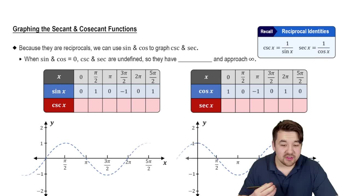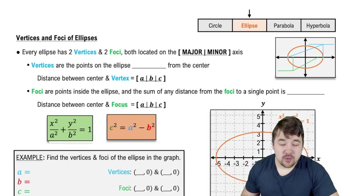Identify the amplitude and period of the following functions.
Table of contents
- 0. Functions7h 54m
- Introduction to Functions16m
- Piecewise Functions10m
- Properties of Functions9m
- Common Functions1h 8m
- Transformations5m
- Combining Functions27m
- Exponent rules32m
- Exponential Functions28m
- Logarithmic Functions24m
- Properties of Logarithms36m
- Exponential & Logarithmic Equations35m
- Introduction to Trigonometric Functions38m
- Graphs of Trigonometric Functions44m
- Trigonometric Identities47m
- Inverse Trigonometric Functions48m
- 1. Limits and Continuity2h 2m
- 2. Intro to Derivatives1h 33m
- 3. Techniques of Differentiation3h 18m
- 4. Applications of Derivatives2h 38m
- 5. Graphical Applications of Derivatives6h 2m
- 6. Derivatives of Inverse, Exponential, & Logarithmic Functions2h 37m
- 7. Antiderivatives & Indefinite Integrals1h 26m
- 8. Definite Integrals4h 44m
- 9. Graphical Applications of Integrals2h 27m
- 10. Physics Applications of Integrals 3h 16m
- 11. Integrals of Inverse, Exponential, & Logarithmic Functions2h 31m
- 12. Techniques of Integration7h 41m
- 13. Intro to Differential Equations2h 55m
- 14. Sequences & Series5h 36m
- 15. Power Series2h 19m
- 16. Parametric Equations & Polar Coordinates7h 58m
0. Functions
Graphs of Trigonometric Functions
Problem 108
Textbook Question
Design a sine function with the given properties.
It has a period of 12 with a minimum value of −4 at t=0 and a maximum value of 4 at t=6.
 Verified step by step guidance
Verified step by step guidance1
Identify the general form of a sine function: y = A * sin(B(t - C)) + D, where A is the amplitude, B affects the period, C is the phase shift, and D is the vertical shift.
Determine the amplitude (A) by calculating the difference between the maximum and minimum values, then divide by 2. Here, A = (4 - (-4)) / 2 = 4.
Calculate the vertical shift (D) by finding the average of the maximum and minimum values. Here, D = (4 + (-4)) / 2 = 0.
Use the given period to find B. The period of a sine function is given by (2π / B). Set this equal to 12 and solve for B: 2π / B = 12, so B = 2π / 12 = π / 6.
Determine the phase shift (C) using the information that the minimum value occurs at t = 0. Since the sine function normally has a minimum at -π/2, set B(t - C) = -π/2 when t = 0, and solve for C. This gives C = π/3.
 Verified video answer for a similar problem:
Verified video answer for a similar problem:This video solution was recommended by our tutors as helpful for the problem above
Video duration:
10mPlay a video:
Was this helpful?
Key Concepts
Here are the essential concepts you must grasp in order to answer the question correctly.
Sine Function Properties
The sine function is a periodic function characterized by its amplitude, period, and phase shift. The amplitude determines the height of the wave, while the period defines the length of one complete cycle. Understanding these properties is essential for designing a sine function that meets specific criteria, such as maximum and minimum values.
Recommended video:

Properties of Functions
Period of a Function
The period of a function is the distance along the x-axis over which the function completes one full cycle. For the sine function, the standard period is 2π, but it can be adjusted by a scaling factor. In this case, a period of 12 means the function will repeat every 12 units along the t-axis, which is crucial for setting the function's behavior.
Recommended video:

Graphs of Secant and Cosecant Functions
Vertical Shift
A vertical shift in a sine function alters its midline, effectively moving the entire graph up or down. This is important for achieving specific maximum and minimum values. For instance, to have a minimum of -4 and a maximum of 4, the sine function must be vertically shifted down by 4 units, adjusting its range accordingly.
Recommended video:

Foci and Vertices of an Ellipse

 5:53m
5:53mWatch next
Master Graph of Sine and Cosine Function with a bite sized video explanation from Patrick
Start learningRelated Videos
Related Practice
Open Question
